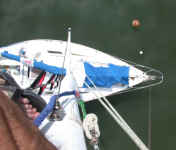
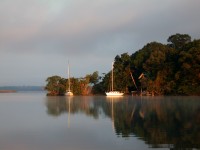

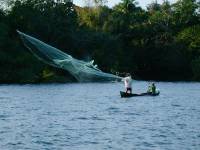
 |
 |
 |
 |
I left Montana the second week of January and flew to Guatemala City, Guatemala. I started to change money in the Miami airport, but the greedy American bank offered an appalling exchange rate, 6 Quetzales to the dollar. When I got to Guatemala City the bank in the airport gave me 7.65, much closer to the real exchange rate. On reflection, I feel sorry for visitors to the United States. The wealthiest country in the world rips off its visitors at the first opportunity. Welcome to the land of capitalism.
My bags were stuffed with boat parts and diving gear. Sometime last summer I got an email message from Jennifer Lindeen, who is watching Malakii while I am away. She had "some bad news and some good news." The bad news was that Malakii had been hit by lightning, in one of the Rio's famous summer thunder bumpers. Guatemalans give their winter storms female names; they are relatively mild, although they can still dump a lot of water and throw their share of lightning. But they give their summer storms male names, a reflection of the violence these storms tend to bring with them. A sad comment on human nature. Everything at the masthead was blown away. The good news was that Malakii was still floating, and everything else seemed to be ok. Another boat about a mile away also got hit. It was brand new, and the strike blew holes in the hull and started a fire in the electrical panel. So I should feel a little better for having gotten off so easy...
I had never flown into Guatemala City before, and enjoyed it. If the weather is good, you get a great view of the terrain -- steep hillsides covered with dwellings and tall mountains in the not very far distance.
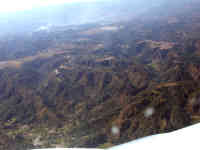 |
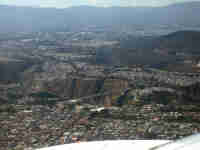 |
 |
| Guatemala City | Guatemala City | Nearby Mountains |
I was very proud of myself on this trip. I have been trying to teach myself Spanish, and two weeks before had gotten up the courage to call and make a hotel reservation. I managed to conduct most of the conversation in Spanish. This never would have happened if I could have dealth with them over the internet, but the hotel didn't have a website or an email address. In retrospect, I'm glad they didn't. I stayed at the Chalet Suizo. I was a bit leary at first of staying in a place named the Swiss Chalet, but it turned out to have no Swiss flavor, thankfully. For about $13 I got a nice clean, quiet room. The hotel is in Zone 1, within walking distance of the bus to Rio Dulce, the market, and a number of interesting sights. However, zone 1 is not the best part of town, and one is encouraged not to walk the streets after dark.
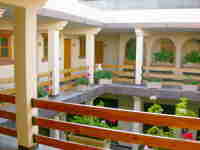 |
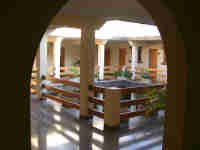 |
 |
| Second Floor Courtyard | Chalet Suizo | Open Air Hallway |
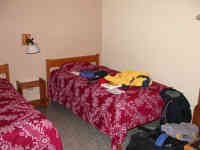 |
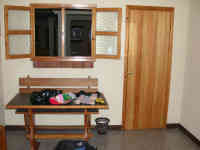 |
|
| My Room |
Since it wasn't dark yet, I searched out the bus station, then wandered up to an area with a park. It seems like even the smallest villages have a soccer field, so it was no surprise to find one in the middle of the park.
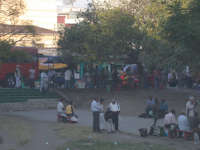 |
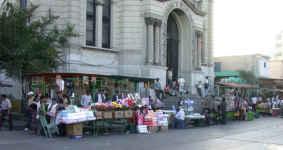 |
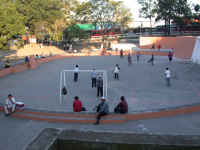 |
| Street Park | Sidewalk Market | Soccer |
The next morning I took the bus to Fronteras, on the Rio Dulce. It cost $5, a bargain in my book. Jennifer's guardian / helper, Chico, met me in the afternoon and took me the fifteen miles or so down the river and the Golfete to Jennifer's.
One of the things I brought with me was a home made "Mast Mate," a kind of nylon ladder you hoist up using a halyard. The first thing I did was put up the mast mate and run up the mast to see what the lightning damage looked like, so I could think about any problems I might have repairing things. The damage was pretty thorough. The balun (impedance matching coil) at the base of the antenna was blown apart, and the antenna itself was melted. The masthead light had a hole blown in the lens, and the light was shattered. The lightning had also blown out all the running lights, and exploded one of the switches on the electrical panel.
I also discovered the cap on the top of the mast was welded on, so that meant I couldn't take it off to insert a new chase for mast wiring. So I had some thinking to do, as I was planning on replacing the wiring.
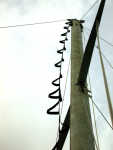 |
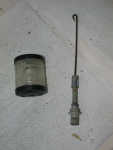 |
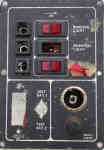 |
| Mast Mate | Lightning Damage | Fried Electrical Panel |
The next day I got out the GPS and VHF radio and hooked them up. Fortunately, I had totally disconnected them and stored them, so they weren't affected by the lightning. Except... the GPS didn't work. Well, it sort of worked. It did everything it was supposed to, except tell me where I was. The lightning had fried the GPS antenna, mounted on a short pole on the stern. It looked ok...
I replaced the VHF antenna, and discovered there already was a chase for wires in the mast, although the VHF cable and two other wires going to the lights at the spreader weren't in it. I left the VHF cable alone, but pulled all the old wires for lights except one, which I left in as a pull wire. Then I replaced the charge controller for the solar panel, which was also fried. I had a replacement for it because it was acting funny when I left, and the company, FlexCharge, sent me a new one with instructions to return the old one "when I had the opportunity." Now that's service, and I will buy from them again.
With all the newly discovered broken equipment, I could have easily been discouraged. But Bahia de Buena Vista, where Malakii is moored, is a delightfully quiet and relaxing place. Parrots flew over in the morning on their way to the grocery or work or school or whever parrots go during the day, squawking and gossiping like a bunch of school kids or little old ladies. Fish slapped the surface in the evening after dark. A few local folks come and go during the day, usually Chico, Jennifer's helper, or a member of his family. Sometimes early in the morning a fisherman would stop by in his cayuco with a large Roballo (Snook) to sell to Jennifer, who smokes them and then sells the smoked meat to cruisers. Every so often a fisherman would come into the bay, either throwing a cast net or putting out hand sets with small styrafoam or pop bottle buoys to mark their location.
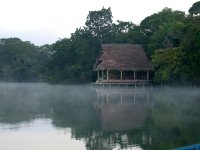 |
 |
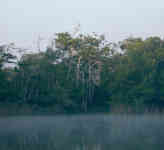 |
| Bahia de Buena Vista | a.k.a. Gringo Bay | |
 |
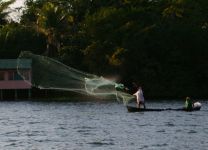 |
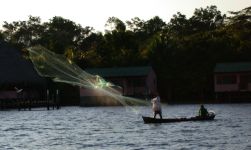 |
| Fisherman throwing Cast Net |
The main floor of Jennifer's house, where the kitchen, dining area, and spacious front porch are located, is a delightful, open affair. It sits out over the water; it's even possible to tie a deep draft sailboat up to the porch. To help make ends meet, Jennifer does a lot of different things. She raises lobsters in ponds behind the house. She raises various plants; while I was there she had some outrageously healthy basil. She paints. She serves dinner, on occasion. She referrs to her place as the Accidental Restaurant, an inside joke on how the idea got started. Some cruisers, very late in the day (uh... dusk) motored in and promptly pulled along side the house, throwing her a line and asking her for some cold beer, and what she had for dinner. No introduction, no nuttin'. After a little awkwardness, they asked if this was a particular restaurant. "Nooooo... that is a few miles back down the lake; this is my house." But it was now dark, they were tired and lost, and Jennifer, being a nice person, offered to fix them a dinner of Roballo. An accidental dinner, at a new restaurant. Please phone ahead for reservations.
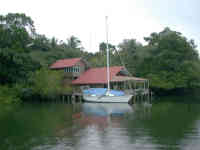 |
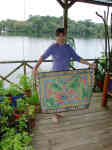 |
| Jennifer's House | Jennifer and a Painting |
With Jennifer's help, I ran new wires up the mast, one to the masthead and one to the spreaders. Then I put up the new masthead light, and a new steaming light with foredeck light at the spreaders. I had dinner at Jennifer's along with Bob Polk and Carol Long, who rent a small house across the bay from Jennifer. Bob is a baking fiend, and brought fresh bread and a cake. We tried out my new hand crank blender that Lynde got me for Christmas, and it made great liquados. When I tested the depth sounder, everything worked except the depth. I thought maybe the transducer was shot, but a few days later another boat (Bigfoot IV) came through with a compatible transducer and the same depth sounder. Harry let me test my depth sounder using his transducer, and I determined my depth sounder was blown. Another casualty of the lightning strike. I couldn't buy one locally, but my friends Doug and Rayene on Kristiana were in the States and could bring one back with them. A few days later I was up in Fronteras, where I got on line and ordered one.
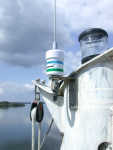 |
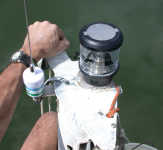 |
 |
| New VHF Antenna | New Masthead Light | New Steaming/Foredeck Light |
 |
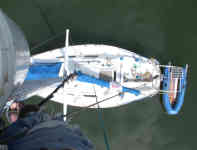 |
|
| View from Masthead |
Then I put an eye splice and thimble in a new line and installed it as a new (extra) halyard / topping lift. The halyards run inside the mast, and unfortunately, the exit plate I had brought down with me was the wrong size. Even worse, nobody seems to make on the right size. So I made a new one out of wood.
I replaced some of the fuel lines on the engine, an attempt to stop a small leak. Then I tried to start the engine, something I had been avoiding. The lightning had trashed a lot more than I originally thought, and I've heard about it doing in engines. How it messes up a diesel engine is beyond me.
The engine wouldn't even turn over, although the solenoid clicked. I spent the next day charging the batteries using Jennifer's generator. But the engine still wouldn't turn over. So I pulled the starter and tested it; it worked fine. I then went over all the starter wiring, and discovered the ground cable was badly corroded where it attached to the engine block. Cleaned it up and ... whoppie!!! What a relief.
However, as the engine was running, I noticed that the bilge seemed to be filling up with water... Yowzer! The engine is cooled indirectly using sea water, which is sucked in through a hole in the hull, circulated through a heat exchanger, and then blown out with the exhaust gasses. One of the exhaust hoses had a crack in it, so the cooling water was being pumped into the bottom of the boat. I thought about it a minute, then turned the engine off :-).
Another boat, Wasabi, pulled in a few days later. Brian and Lisa had two extra GPS antennas, but they weren't the same kinds as mine. They weren't even the same manufacturer. My GPS is a Furuno, and theirs is a Garmin. I suspected the antennas might be compatible. Brian let me try one out, and it worked. So I bought it from him and installed it. Unfortunately, the cables on them come out of the housing, and are soldered directly to the board in the antenna, and they are itty-bitty short wires. So I took the cable off and replaced it with the one from my fried antenna. It was a tedious task, but it worked.
I had also brought a small butane soldering torch down with me, so I could solder heavy wires without a need for AC power. My soldering iron will work using my small inverter, but it isn't hot enough to do heavy wiring. But I couldn't bring butane down on the plane. I figured I could buy it in Fronteras, but when I tried, nobody had any. Grrr... Fortunately, Brian had an extra can which he also sold me. Unfortunately, the tip of it was trashed, so it wouldn't fill my torch. When I tried, it just squirted butane gas all over, freezing everything as it vaporized. I eventually managed to carve a small tip to fit, and sealed it using putty when I went to fill the torch.
It took me over a week to locate a piece of exhaust hose the right size, but eventually I got one from Brian on Mustang . He was very generous and gave it to me. I was delighted to be able to return the favor a week or so later when I decided to get rid of the pilot berth cushions I had been carrying around and had no use for.
Last year I spent many weeks being frustrated with the engine dying unexpectedly. Eventually I figured out it was because there was a sag in the fuel tank vent line, and it had water or fuel in it. So I rerouted the vent line so it wouldn't have a sag in it.
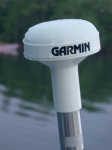 |
 |
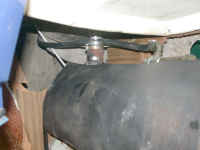 |
| New GPS Antenna | New Engine Exhaust Hose | Rerouted Fuel Tank Vent Hose |
I wasn't in a particular hurry to get things done and leave Guatemala, as swinging on the mooring in Bahia de Buena Vista was pretty pleasant. Every morning the parrots would fly over, gossiping on their way to work or breakfast or the market or whereever they were going. In the evening the bay would come alive with the sound of splashing fish. I started cutting up my garbage really small, and threw it overboard a little at a time. Eventually it got to where the water would boil with fish, some of them pretty big.
I interspersed my days working on the boat with a few days helping Jennifer out. One day I replaced her satellite phone antenna, which fixed her phone better than it had ever been.
At dinner one night, someone mentioned that President Bush gave all federal employees a holiday for his inauguration. $40 million for ten balls, one security person for every five party goers. Jennifer added, "And those were his supporters." I had to laugh. Wish I could think that fast.
One day when I was up in Fronteras I went to the ATM to get some cash, and discovered my card had expired. Uh-oh... I called the bank, but they couldn't extend it. The new card had already been mailed, the week I left. I sent an email to my friends Doug and Rayene from Kristiana. I called my friends at home who were gathering the mail, and they found the card and FedEx'ed it to Doug and Rayene. A week or so later I was much relieved.
I installed the new depth sounder, and a through-the-hull transducer to go with it. I'm not particularly happy with the sounder, as it is very difficult to read in bright light. However, it does read accurately, and works reliably. Unfortunately, the cable on the transducer is only twenty feet long, too short to reach the instrument mounted in the cockpit. In addition, the cable has a weird proprietary connection, not the standard phono plug connection most simple transducers use. The company wanted about $25 for an extension cable, and I would need to spend another $25 or so to get it down to Guatemala. Instead, I fabricated a connector out of some nails, heat shrink, and liquid electrical tape.
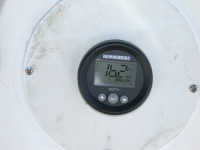 |
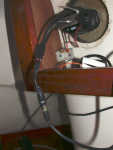 |
| New Depth Sounder | Depth Sounder Cable Adapter |
Two other small jobs I got done were making a new handle for the companionway hatch cover, and installing a padeye for clipping in a safety harness in the cockpit.
 |
 |
| Cockpit Padeye | Companionway Hatch Handle |
My last big job before leaving was to finish the harbour awning. I had brought it home with me last year, and sewn it back together. But I needed to put some loops on it to hold the PVC sections I wanted to use to support it.
I had marked the position for the loops, and had jury-rigged the awning for a week or so. To support the awning, I was using four lengths of 1/2" PVC tubing bent in an arch. Each arch was made using two lengths of tubing, joined with a coupling at the peak. That made it easier to take apart and put up, and to stow the tubing down below. Unfortunately, without the loops on the awning, the arches tended to move around a lot in a breeze, and eventually the couplings would come undone. On two occasions, one of the sections of PVC tubing slid overboard. Ooops. Fortunately, I had my dive gear and air in my tanks, so I used my not-so-well-honed underwater search skills to find the errant pieces of tubing. It was rather difficult and tedious because the bottom is thick silt and easily stirred up, and the visibility is only a foot or two to start with. The first time, I swam a pretty good pattern and was pleased with my efforts, although I was not pleased with my level of anxiety with the low visibility and muck. The second time, I blew my pattern and only covered half of the desired area in the first two patterns. Fortunately, I had a buoy over the place where I thought I lost the tubing (I had tied a dive weight to a line attached to a boat fender and thrown it overboard shortly after the PVC tube went on walk-about.), and I could restart my pattern there covering the portion I had missed. Good practice, and humbling.
To sew on the loops for the tubing arches, Jennifer let me use her sewing machine, in her studio, run by AC power from her generator. However, when I started work, the power went off. After some snooping with my voltmeter, I determined there was a break in the wire somewhere. The wire is two separate strands, directly buried, from zero to two inches deep. It runs this way and that, for about a hundred yards, through the garden and over to the studio. It was probably not approved by the local building inspector... or maybe it was... We located the wire in a few places, and found where the branch to the studio was spliced in. Fortunately, Chico has a good memory, and said he remembered cutting the wire a few years back with a shovel, and they had spliced it back together. We dug around in the dirt for a while and located the splice, which was trashed. I spent a few hours building a better splice, then went to work on the harbour awning.
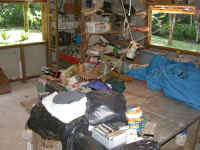 |
 |
| Jennifer's Studio | Studio Wiring |
One of the great mysteries about Malakii has been what the name means. My searches on the net have revealed nothing illuminating, and the former owners are no better informed. At one of the swap meets, a regular Saturday morning event on the Rio, Jennifer introduced me to a man from South Africa who said he knew what it meant -- "My Angel" in Swahili. I can live with that. However, when I asked him how it was spelled, he didn't know. I looked it up when I got home, and it's Malaika, not Malakii. Derived from the Arabic Malak, about which I can find little. I have one former boat paper that shows the name as Malak II, but nothing to support it. Second angel?
One of the stanchion braces broke last year, so I needed to get a new one made. In order to get it made and fitted properly, I needed to remove the old one from the boat. Something I would need to do to put the new one on in any case. Unfortunately, years of being connected and never touched meant that things were corroded a bit, and nothing would come undone. I ended up taking the whole forward port lifeline off. One more weird frozen connection and I would have had to cut something or take the whole boat up to the welding shop. I took the spaghetti mix of stanchions and lifelines into Jennifer's shop and managed to drill out a bad setscrew, after which everything could come apart and I could put it all back on the boat except for the one piece I needed to take to the shop. "Oh, the stanchion brace is frozen to the stanchion post..."
I retrieved my outboard from storage in Jennifer's "garage", but when I went to put it on the dinghy I discovered the big screws that mount it on the transom were frozen. After some WD-40 and oil and a lot of time and patience, they came loose. When I hooked things up and went to start the motor, I couldn't get the gas hose to attach to the tank. When I finally got it connected and squeezed the bulb to prime the engine fuel bowl, air started bubbling out a crack in the tank fitting. So I took some marine tex epoxy and repaired the crack. Amazing stuff, it held. The engine started reasonably easily, considering it hadn't been run for eight months. But the cooling water stream wasn't as large as I thought it should be. Chico thought it might be partially plugged by Tabanos trying to build a nest in there, so I ran a coathanger up it. I didn't see much come out, but the next time I ran it it worked much better.
Jennifer told me she had some visitors coming who were interested in a species of old cocoa beans rumored to grow in the area. Chico said he knew people who knew where there were some, so he was going on a search for them. I was invited, but needed some rubber boots because of the possibility of encountering the very poisonous Fer-de-Lance snake. A machete also, which I have, but it probably needs sharpening.
The locals are deathly afraid of the Fer-de-Lance, which they call a barba amarilla ("yellow chin"). It is a pit viper, and the most dangerous snake in Central and South America. On average, it injects 105 mg of venom in one bite; the fatal dose for a person is about 50 mg. The locals kill every snake they meet, but they are afraid to even touch a barba amarilla -- even a dead one. Jennifer makes hats, and skins and dries snake skins to put on her hats. She pays the locals for snakes for her hats. They bring her barba amarillas, with the head cut off, draped over the tip of a machette on an outstretched arm. She blithely picks it up and inspects it, to their horror and astonishment and awe. I told her all that is good, it probably enhances her image and her protection. Don't mess with the snake lady.
 |
| The Snake Lady |
Jennifer got a call one day asking her if she or any of the people she knows knew where there were any of the "old, long" chocolate trees. Some people in the chocolate business were looking for a particular kind of chocolate bean, known as Cacao Cimmaron. Chico said he knew sort of where there were some, so one day we went on a chocolate hunt. We would be walking through the jungle, so I needed some rubber boots to protect me from snake bites. Unfortunately, the day I wanted to go to town to buy some, my ride got sick, so I didn't get any. Not to worry... chico had an extra pair I could borrow. I crammed my size 13 (47 European) feet into his size 9 (43 European) boots, and off we went.
We took Jennifer's lancha around to the next bay, then followed a creek up as far as we could. We were in the middle of a big farm / ranch, and were immediately approached by a man on horseback. Chico knows everybody, and everyone knows him, so after some pleasantries we continued on our way, hiking up a path until we got to a road, then along the road for a few miles. Along the way we crossed crica blanca, the small creek which dumps into the Golfete near Jennifer's house. After a while Chico started asking people about Cacao Cimmaron trees. The first guy that had some took one look at the gringo accompanying Chico and decided if there was a gringo along they must be valuable, and said they would cost 100 quetzals for each fruit. Chico politely said no thanks, and we continued on.
It was very interesting watching Chico communicate, even though I couldn't really understand the conversation. Nothing was ever hurried. We would exchange pleasantries, people would ask who the heck I was, usually mistaking me for Chico's benefactor. He would tell them no, I'm just a friend, along for a walk to see the scenery. This they universally found hard to swallow. I just smiled and said hello. Eventually we found some other folks who knew where there was some of the old chocolate. After about 15 minutes of exchanging the news, one of them took us for a hike up through the village into the jungle to where the trees were. We got a few of the bean pods, two for 5 quetzals.
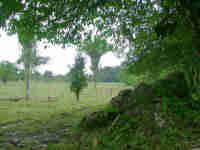 |
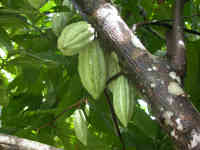 |
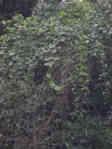 |
| Guatemalan Farm | Long Chocolate | Big Seed Pod |
After collecting the chocolate, Chico took me up a trail that lead part way up the mountain on the south side of the Golfete. We followed a small creek, different from the one where we left the boat. The creek had some pretty falls, and was full of snails at one spot. There were some pretty flowers along the way, but I don't know what they were. I think one was some kind of orchid. Eventually we came to a small Mayan village perched on a ridge, with a gorgeous view of the lake. The kids were friendly, although shy, and the adults were definitely shy. I felt as if we were intruding, although they did have a small store, or at least a place to buy things, which they opened up to sell us something to drink when we asked if they would.
 |
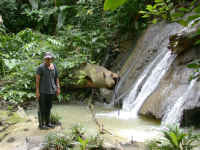 |
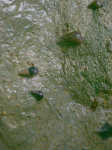 |
| Creek | Chico by Falls | Snails |
 |
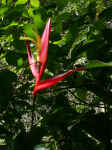 |
|
| Flowers | ||
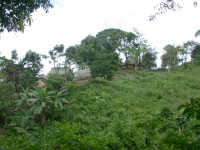 |
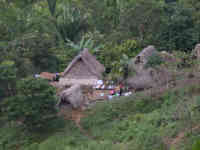 |
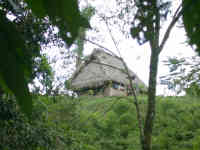 |
| Mayan Village | ||
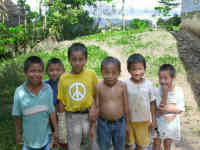 |
||
| Mayan Kids | ||
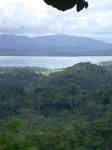 |
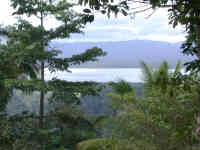 |
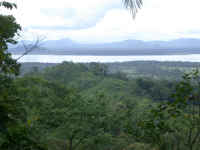 |
| Golfete |
At long last, I had everything ready to go. Except that the propeller shaft was binding. As nearly as I could determine, it was binding in the cutlass bearing. I had made it last year, after I returned from cruising and hauled Malakii to paint the bottom and weld the prop shaft strut. It had been a little tight, but I had thought it would loosen up with use. I had thought the four or five hours of motoring I had done on my way down to Jennifer's would have done it. In any case, rotating the shaft numerous times by hand didn't make it turn any easier. I didn't have too many options; there is no clutch to ease it into gear, and putting it in gear at low rpm just stalled the engine. I was reluctant to jam it into gear at higher rpm for fear of tearing up the transmission. So I sailed up to Fronteras, and arranged for Carlos "the welder" to haul Malakii. He has a big trailer he built specifically for hauling boats. He uses the boat ramp more or less under the big bridge on the south shore. While we were hauling Malakii, some other folks were loading a big cayuco with cinder blocks. Now there was a load of freight!
 |
| Cayuco Freighter |
I filed out the inside of the makeshift cutlass bearing, and made a note to bring a new one down with me next year. After splashing, I sailed back down to Jennifer's, where I picked up her old SSB radio which I had bought. Then it was time to head out to the cays, and hopefully some fun snorkling and diving and poking around. I got a late start, as Carol and Bob invited me to a chilli lunch.
Also at lunch were Patti and Ted, from the boat Ibis. They built Ibis ten years ago. I was impressed by their refrigeration unit, and the composting toilet they have on board. They've had the composter for ten years, and love it. No problems, no stink, no thru-hulls, no holding tank. They empty it every few weeks, which they can do pretty much anywhere.
Lunch was YUMMY! We had shredded cabbage and cheese and salsa to add to it, and fresh baked corn bread to go with it.
 |
| Carol, Bob, Gary, Patti, Ted |